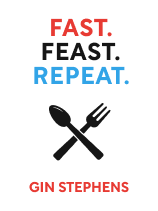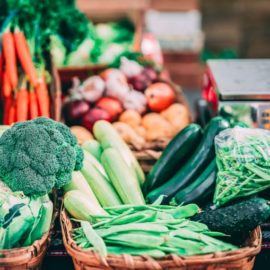

This article is an excerpt from the Shortform book guide to "Fast. Feast. Repeat." by Gin Stephens. Shortform has the world's best summaries and analyses of books you should be reading.
Like this article? Sign up for a free trial here .
What is Gin Stephens’s Fast. Feast. Repeat. about? How does adopting intermittent fasting (IF) as a lifestyle help you improve your health?
Fast. Feast. Repeat. is a practical self-help guide that explains intermittent fasting (IF) as a lifestyle and approach to overall well-being. Among other benefits, Gin Stephens argues that IF can help you lose weight, feel better, fight disease, and live longer.
Below is a brief overview of Fast. Feast. Repeat. by Gin Stephens.
Intermittent Fasting Is a Way of Eating
To start, we’ll explain what intermittent fasting is and what it can do for you.
Stephens explains that intermittent fasting is simply a way of eating—it’s about changing how you eat. This distinguishes it from diets, which restrict what you eat. For instance, keto is a diet since it has a yes/no food list, while intermittent fasting doesn’t require you to restrict what you eat.
(Shortform note: As another example of a “way of eating” versus a diet, consider the standard “three square meals” pattern. It’s a way of eating, not a diet, in that it prescribes three daily meals, spaced roughly equally throughout the day. It doesn’t prescribe what you can eat—just when. Using this standard pattern, you can follow many different diets—keto, the standard American diet, paleo, Atkins, and so on. The same is true for intermittent fasting.)
To do intermittent fasting, you simply cycle between periods of fasting and periods of “feasting” or eating. Regular fasting yields benefits such as increased energy and fat loss, and the feasting periods allow you to eat without the stringent rules of a typical diet.
Stephens stresses that intermittent fasting is not a diet. Instead, IF will help you relearn to eat intuitively, enjoy special occasions without guilt, and achieve a healthy relationship with eating.
Fasting Is Superior to Dieting
In Fast. Feast. Repeat., Gin Stephens explains that when we eat, our blood glucose (blood sugar) levels increase. In response, our bodies release insulin, a hormone that stores excess glucose in the liver and muscles as glycogen. If any blood glucose remains after this step, insulin converts it into fat and stores it away.
By storing this glucose-based energy, insulin lowers your blood glucose. When your blood sugar runs out and you need energy, the pancreas signals for your liver to release some of its stored glycogen to use as energy. When those glycogen stores run out, you enter the fasted state.
In the fasted state, your body converts your fat stores into ketones, a fat-based energy source. Put another way, you’ll burn your fat as fuel (a state called ketosis). We evolved to burn fat for energy when food was scarce, so you’ll do so only after depleting your blood glucose and glycogen stores.
Modern Eating Habits Cause Weight Problems
According to Stephens, the modern habit of eating continually causes high blood glucose levels—that is, the body never gets a break from converting food into glucose. This leads to chronically high insulin levels, since insulin releases to store all that glucose. Since we’re never out of glucose or glycogen, the body can’t access its fat stores, burn them, and lose weight.
(Shortform note: In The Obesity Code, Jason Fung argues along these lines in more detail. Continuing the “wallet and bank” metaphor, he argues that, as with money, we prefer to use our wallets (glycogen)—and when we deplete them, we’d rather fill them back up than get money from the bank (fat stores). By eating without long breaks, you prevent your body from accessing fat stores, and at the same time you keep your insulin levels high, which promotes increased storage of glucose as fat. In Fung’s view, this leads to obesity.)
Dieting Doesn’t Facilitate Sustainable Fat Loss
Stephens explains that diets don’t lower insulin levels enough to deplete your glycogen stores and start burning fat. This is because diets work on the logic of “calories in, calories out”—that is, eat less than you need and you’ll lose weight.
(Shortform note: Fung agrees, and he argues that dieting doesn’t lower insulin levels because it doesn’t address insulin resistance. In short, chronically high insulin levels—such as from constant eating—cause your cells’ insulin receptors to become insulin resistant: They need more stimulation (more insulin) for glucose to enter the cell. Eating less doesn’t solve this because any eating stimulates the release of insulin. The solution, he asserts, is to regularly fast for 24 to 36 hours, since fasting gives your body extended time to break down insulin.)
While dieting or eating less works temporarily, it also causes metabolic adaptation, a scenario wherein your metabolism slows down to deal with perceived starvation. It works like this: When you eat fewer calories than you need to maintain your weight, your body thinks you’re starving. Then, Stephens says, it makes three changes to handle the situation:
- The hunger hormone, ghrelin, increases. This makes you want to eat more.
- The satiety hormone, leptin, decreases. This makes you less satisfied, so you’ll want to stuff yourself.
- Your metabolism slows down. This lowers your energy levels and slows you down, so that you can “survive” until food becomes available again.
Diet for long enough, and your metabolism settles in at that slower pace—that’s the “adaptation” in metabolic adaptation. Then, you’ll need to eat even less to continue losing weight, since you aren’t burning as much energy—creating a downward spiral of hunger and slowing metabolism.
Fasting Promotes Effective Fat Loss
Dieting typically doesn’t involve fasting, so when you diet, you never use the built-in fat burning mechanism your body already has. Here’s how to access it.
Since our bodies are used to overeating, we need to teach them to access our fat stores again. According to Stephens, when you start fasting, your body won’t yet know how to burn fat and will instead slow your metabolism to save energy until you can eat again.
Since insulin releases when you eat, fasting allows insulin levels to decrease. Then you can use up your liver’s stores of glycogen and begin to access your fat stores. If you fast often enough, your body will “remember” it has fat stores to burn for energy.
Unlike dieting, where you never stop eating long enough to start fasting, intermittent fasting promotes sustainable fat loss. Each time you burn fat for fuel, you’ll lose some weight—and with fasting, you’ll also eat enough each day, so you won’t cause your metabolism to slow down.
Health Benefits of Fasting
Stephens explains three main health benefits of intermittent fasting, in addition to fat loss:
Benefit #1: Fasting promotes autophagy, which Stephens calls your body’s natural recycling process. Autophagy takes damaged or aging cellular materials and breaks them down into raw material that can become new cells and compounds. Autophagy is a key bodily process that helps prevent disease—everything from cancer to aging and neurodegenerative disorders.
Benefit #2: Fasting is great for your heart and brain. Research has linked fasting to improvements in various aspects of cardiovascular health, including reduced blood pressure, cardiovascular stress response, and your heart tissue’s ability to heal damages.
Other studies found that intermittent fasting increases levels of brain-derived neurotrophic factor (BDNF), a compound that helps neurons resist degeneration. This improves cognition and reduces risks related to Alzheimer’s disease, Parkinson’s disease, and depression.
Benefit #3: Fasting may fight aging. According to Stephens, research found that fasting can increase metabolites—compounds produced by metabolic processes—that help maintain muscles and promote anti-aging antioxidant activity.
Leave Behind the Dieting Mindset
Now that we’ve covered how intermittent fasting works with the body to promote weight loss, let’s look at how to leave behind the dieter’s mindset and instead adopt an IF mindset.
Overcome Dieting Confusion
Stephens explains that decades of contradictory advice about how and what to eat has created immense confusion, a tangle that she calls “diet brain”: When you no longer have any clue how to eat “properly.”
Recent research suggests that there’s no such thing as a universally optimal diet. Instead, different individuals seem to respond differently to the same foods. This is called “bio-individuality.” For instance, you might do well with whole wheat bread while a friend doesn’t.
Stephens explains that this gives us good reason to stop thinking about dieting as a moral issue. As she explains, dieting causes you to think in terms of “good” or “bad” behavior, and we’ve learned to punish ourselves for being “weak,” if we fail at dieting. But since there’s no universally perfect diet, there’s nothing to fail at. You’re simply learning how your body works, and you can stop worrying about whether you’re “falling off” the diet.
(Shortform note: The idea of bio-individuality originates from the Institute of Integrative Nutrition, a for-profit organization that teaches a course in “Health Coaching” and advocates for bio-individuality. In the update we’ve linked, the IIN explains that the National Institutes of Health (NIH) has begun to study the value of precise, individualized health plans—lending credibility to the concept. They also note that the studies used to produce the standard blanket diet recommendations—such as the food pyramid—used only 3% of participants from African or Hispanic ancestry.)
Learn to Eat Intuitively
Since there’s no perfect diet, Stephens says we can stop worrying about the conflicting diet advice. Instead, learn to intuitively regulate your eating by getting back in touch with your body’s natural appetite signals.
Ghrelin signals when we’re hungry, and leptin signals when we’re satisfied. As infants, we can easily sense these signals and know when we’re hungry or full. But we lose touch with them as we age, making it easy to overeat and gain weight. According to Stephens, intermittent fasting helps you tune back into your appetite signals. When you’ve tuned back in, you can use those natural signals to eat what feels best to you and to “stop when satisfied.”
(Shortform note: The notion of “intuitive eating” originates from a 1982 book called Diets Don’t Work by Bob Schwartz. He advocated, simply, to eat only when you’re hungry, to eat slowly, and to stop eating when you’re full. The idea was popularized in 1995 in Intuitive Eating by Evelyn Trible and Elyse Resch, who detailed how to overcome the “dieter’s dilemma”—the conflicting desires to be thin and to binge on treats—by rejecting the “diet mentality.” Given the similarity of these terms to Stephens’s (“diet brain”), it’s likely she lifted her ideas from this earlier work.)
When tuning back in, it takes time for your appetite signals to reset. To help get you there, Stephens offers the following tactics:
- Tactic #1: Eat less than you normally would—You can do this by remembering “hara hachi bu,” an Okinawan practice that means “eat until 80% full.”
- Tactic #2: Be mindful of your experience—If you notice a “sigh” of contentment, that’s one signal to stop eating. If you notice that the food has lost its initial deliciousness, that’s another signal.
(Shortform note: In Intuitive Eating, Tribole and Resch argue that one key to healing your relationship with food is to focus on the process. In this view, weight loss isn’t the goal so much as a side-effect of your commitment to eating well. As you learn to listen to your body and eat when you’re truly hungry—and to eat what your body truly wants and needs—you’ll naturally trend toward a healthy weight for your body.)
Fast Properly and Feast Well
Now that you know how to think like an IFer, we’ll explain the “clean fast”—Stephens’s approach to fasting—and her “delay, don’t deny” approach to feasting. Afterward, we’ll detail how to time your fasting/feasting cycles with various rhythms.
Fast Cleanly by Avoiding Foods or Flavors
According to Stephens, you must do a clean fast to get the full benefits of fasting. The main three purposes of clean fasting are insulin regulation, ketosis, and autophagy:
Purpose #1: Regulate your insulin. Since insulin prevents effective fat burning, you’ll want to avoid eating, period. Further, avoid consuming any flavors—sweetness, sourness, and umami flavors all activate the insulin response.
(Shortform note: While Stephens approves coffee for her clean fast, some studies indicate that coffee consumption may briefly increase insulin levels. As such, abstaining from coffee could result in a cleaner fast than not doing so.)
Purpose #2: Activate fat-burning. Fasting burns fat by activating ketosis—using fat stores for fuel. Don’t consume anything that gives your body an external source of fuel.
(Shortform note: Healthline reports that if you want to activate ketosis, eat fewer carbohydrates. Carbs convert directly into blood glucose, which your body will use for fuel. The fewer carbs you eat, the less glucose and glycogen you’ll need to deplete each time you fast in order to reach ketosis.)
Purpose #3: Activate autophagy. Many of fasting’s benefits come from autophagy, so avoid eating anything, including vitamins and supplements. Research found that taking supplements may reduce autophagy and increase insulin levels.
(Shortform note: While fasting is the main way to activate autophagy, you may also be able to do so by following the keto diet. In short, keto involves eating minimal carbs and increasing your fat intake. This stimulates ketosis, during which autophagy ramps up—so fasting combined with keto may be the best way to regularly benefit from autophagy.)
In short, to fast cleanly means to eat nothing that hinders the above purposes. Stephens provides the following breakdown of what you can and can’t eat on a clean fast:
| Can Eat | Unflavored water, black coffee, plain tea made from camellia sinensis, mineral, sparkling, and seltzer waters, club soda, salt and electrolytes, doctor-approved medications | According to Stephens, bitter flavors from coffee or tea don’t activate the insulin response. Nor do non-flavored beverages, salt, or medications. |
| Gray Area | Peppermint oil, herbal teas, vitamins and supplements | These items may activate the insulin response. After adapting to IF, try them out one at a time. |
| Can’t Eat | Any food, flavored waters and drinks, diet sodas, coffee creamers or fatty add-ins, sweeteners (even if zero calorie), gum, mints, breath strips, workout supplements | All of these items activate the insulin response. There’s no need to eat while fasting—that’s the point! |
(Shortform note: While Stephens asserts that you’ll only reap the full benefits of fasting by following her guidelines, other practitioners allow for some consumption during the fasting period. This is because different IFers have different goals: Martin Berkhan, author of The Leangains Method, recommends taking BCAA supplements prior to exercise—his goal is bodybuilding. To better understand how you should fast and feast, consider your own goals: Do you want to lose fat, gain muscle, or simply maintain good health? Depending on the answer, you have more or less room to compromise with Stephens’s relatively strict plan.)
Feast on Quality Foods Plus Some Treats
Stephens explains that when it’s time to eat, you can eat whichever foods you want. She recommends following her “delay, don’t deny” principle and eating mainly quality foods.
- To delay means to wait until your fast is over and it’s time to eat. Most often, this means waiting until your daily fast ends. However, you might also delay consuming a given food that would hinder your weight loss efforts—such as pizza—until you reach your goal.
- Don’t deny means that there’s no list of banned foods. When it’s time to eat, enjoy what you’d like to—whether it’s a cheeseburger or a salad is up to you.
However, don’t deny does not mean that you can eat as much as you please. If you overeat, you’ll store excess blood glucose as glycogen and fat. If you can’t empty your glycogen stores in each fast, your body won’t be able to access and burn fat as fuel. In this case, you’ll maintain or gain weight.
(Shortform note: In Intuitive Eating, Tribole and Resch recommend that you honor your hunger as a key step to healing your relationship with food. If you deny your hunger, you’ll reinforce the dieting mindset that causes yo-yoing between self-deprivation and bingeing. Instead, give yourself “unconditional permission to eat” and pay attention to your hunger signals to learn when you’ve had enough.)
While Stephens’s approach allows you to eat as you choose, the quality of your food does matter. So while desserts aren’t off-limits, you can’t exclusively eat treats and expect to feel good or lose weight. This is because not all calories are equal: 100 calories of candy is empty of nutrition while 100 calories of vegetables is nutrient-rich.
(Shortform note: While Stephens allows for some ultra-processed foods in her lifestyle, Michael Greger argues in How Not to Die that highly refined foods are never good for us. They’re at the root of numerous modern diseases, and they desensitize your palate so that normal foods don’t taste as good. Given this, it might be easier to go cold turkey from ultra-processed foods rather than trying to eat them in moderation. After all, they’re engineered to encourage overeating, which Stephens acknowledges—so if you keep them in your diet, you might find yourself struggling to eat in moderation.)
Stephens recommends using the NOVA classification system to choose what you eat:
- Food Type #1: Unprocessed or minimally processed foods—This includes whole foods such as fresh fruits and vegetables, meats, fish, nuts, and dried or crushed foods like nuts.
- Food Type #2: Processed culinary ingredients—This includes foods prepared with traditional processing methods such as milling, grinding, or churning. Flours, sugars, butters, and salts fall in this category.
- Food Type #3: Processed foods—These foods result from the combination of unprocessed foods and processed culinary ingredients, and they resemble whole foods. Think homemade bread, yogurt, tofu, or pickles.
- Food Type #4: Ultra-Processed foods—This category includes highly processed food-like items made primarily from food-derived ingredients, preservatives, flavors, and other chemical compounds. Think Cheetos, chicken nuggets, ice cream, grocery store bread, or Twinkies-style snack foods.
Stephens explains that ultra-processed foods contribute to overeating and obesity, and she recommends eating them infrequently, if at all. Instead, eat mainly foods from the first three categories, shop in the produce and deli sections of the grocery store, and avoid eating things that your great-great-grandparents wouldn’t recognize as food.
(Shortform note: In Fast Food Nation, Eric Schlosser explains that in addition to their contribution to obesity and food addiction, the ultra-processed foods created by fast food companies and agribusiness have decimated independent farmers and exploited workers for decades. Farmers receive a pittance for the food they produce, while laborers in fast food chains and slaughterhouses withstand poor working conditions and an aggressively anti-union environment. To overcome this, Schlosser suggests that the federal government needs to pass antitrust laws and put the power back with the people.)
How to Time Your Fasts
According to Stephens, there are multiple “rhythms” or patterns of fast, feast, repeat that you can use. The two main categories are time-restricted eating and alternate day fasting. Each has its own benefits and suitable use cases.
Time-Restricted Eating (TRE)
This is a popular fasting rhythm wherein you divide each day into a fasting period and a feasting period. For example, you might fast for 18 hours and feast for six (notated as 18:6). Stephens explains that TRE works well for weight maintenance.
During the fasting period, follow Stephens’s clean fasting guidelines. Lipolysis (fat-burning) activates between hours 12 and 16, and increases between hours 18 and 24. During the feasting period, eat according to the principles in the previous section. Spread your eating between one or two meals and a snack or two.
Popular timings include 16:8, 19:5, 20:4, and One Meal a Day (OMAD), which usually features a two- to four-hour eating window. Stephens encourages you to pick a timing that works for your goals: Longer fasts burn more fat while shorter fasts work well for maintenance.
Alternate-Day Fasting (ADF)
Alternate-Day Fasting involves alternating days of fasting and days of eating normally. For instance, a 5:2 ADF rhythm means that you eat normally on five days of the week and fast on two days of the week. According to Stephens, ADF works well for intensive fat loss.
On your fasting days, you can fast completely or eat a 500-calorie meal to keep yourself going. The first option increases fat burning due to the longer fast, while the second still works but is easier. Either way, fast cleanly to ensure that you burn fat, activate autophagy, and lower insulin.
On your eating days, eat slightly more than you need—around 110% of your typical intake—and don’t restrict your eating in any way. Research indicates that “overfeeding” temporarily increases metabolism while restricting your eating can slow down your metabolism.
Popular patterns include 5:2, 4:3, and “True ADF,” which means alternating up-and-down nonstop. A 5:2 pattern is the most flexible since you can adjust the days on which you fast, while the 4:3 pattern and “true ADF” are more rigorous. Whichever pattern you choose, avoid ever having two fasting days in a row—always follow a fasting day with an eating day.
Start Fasting: The Quickstart and Beyond
Having covered the science, mindset, and guidelines of intermittent fasting, let’s put what we’ve learned into action. We’ll outline how to start intermittent fasting by committing to a four-week adaptation period, and we’ll explore the changes you’ll experience while adapting to IF.
Commit to a Four-Week Quickstart
To get you started, Stephens lays out a four-week program during which you’ll adapt to IF by depleting your glycogen stores and teaching your body to access your fat stores. While adapting, be consistent and patient. Follow through with the full four weeks once you start. If you dabble, your body will struggle to adapt and you’ll delay the benefits of IF.
Keep your fasting clean: Follow Stephens’s clean fasting guidelines to teach your body to access its fat stores. You’ll gradually deplete your stored glycogen and cue your body to search for an alternate source of fuel—your fat.
Do not change what you eat during this four-week period. Adapting to IF is a large change, and another—such as diet change—can overwhelm you and hinder the process.
Stephens offers three approaches to begin fasting: An easy, medium, and hard approach. In each, you’ll build from shorter fasts and longer feasts to longer fasts and shorter feasts. Below, we’ve notated the fast/feast windows with the x:y ratios explained in “How to Time Your Fasts.” Pick one and follow the fasting/feasting patterns prescribed for each week.
- Approach #1: Easy—In week one, 12:12. In week two, 14:10. In week three, 16:8. In week four, 18:6.
- Approach #2: Medium—In week one, 16:8. In week two, 17:7. In week three, 18:6. In week four, 19:5.
- Approach #3: Hard—In weeks one and two, 18:6. In week three, 19:5. In week four, 20:4.
(Shortform note: In Tiny Habits, Fogg also argues that we should treat behavioral change as a scientific experiment instead of a judgment of motivation or willpower. If the approach you choose is too tough, consider that you might’ve asked yourself to make too big a change with too little motivation, ability, or no good prompt. Reflect on what didn’t work, and then use Fogg’s technique: Brainstorm several behaviors that could help you adapt to IF, and pick the “golden behavior”—the option that’s both feasible and impactful.)
Common Changes While Adapting
Once you begin, your body needs to get used to fasting instead of having the glucose from consistent eating. When that glucose isn’t available, you might experience lethargy, headaches, and fatigue. This means your body is depleting your glycogen stores. After a few weeks (usually three to four, or eight at most), you’ll experience heightened energy and ease during your fasts.
Stephens stresses that it’s fine if you get hungry during your fast—this happens to everyone. Know that hunger tends to come in waves that pass. It won’t build forever or overwhelm you. However, your appetite will likely increase since your body can’t access your fat stores very well yet. Once your body learns to access fat for energy, your appetite will settle down.
(Shortform note: Harvard Health explains that alternate-day fasting causes headaches and lethargy more often than time-restricted eating. If you experience severe pains, they recommend using TRE instead of ADF or fasting less frequently. In addition, they note that fasting often causes overeating since your appetite hormones ramp up while you aren’t eating. To avoid this, they recommend easing into IF by gradually decreasing your eating window over a period of several months—much more gradually than Stephens prescribes.)
Adjust Your Approach
If your first approach doesn’t work out, Stephens recommends you switch to another. If it was too easy, pick a harder plan. If it was too hard, pick an easier plan.
(Shortform note: While Stephens suggests an evening eating window, other studies indicate that a morning eating window may be better. Research found that people’s cognition and memory were stronger when they’d eaten breakfast. Those who fasted early in the day also struggled to exercise on an empty stomach, and eating late has been linked to weight gain.)
After finishing the four-week adaptation period, you can further adjust your approach. Stephens explains that it’s up to you to customize your fasting lifestyle and find what works best. This is as simple as trying out different fasting rhythms, paying attention to how you feel, and adjusting until you feel great.
Each time you make an adjustment, give your body at least two weeks to adjust before judging how something works for you. Listen to your body’s signals—if you feel great, that’s a good sign. If you feel moody or nauseous, try adjusting your approach again.
(Shortform note: In The 4-Hour Body, Tim Ferriss argues that self-experimentation is the best route to knowing yourself. By experimenting extensively with his diet, exercise habits, and more, he learned how to rapidly build muscle, improve his sleep, and lengthen his life. Ferriss recommends finding the “minimum effective dose” to change something in your life, and he advises changing only one aspect of your lifestyle at a time.)
Lose Weight With Intermittent Fasting
Let’s look at how to use intermittent fasting to lose weight. We’ll cover measurement tactics, how to overcome plateaus, and how to maintain your weight once you reach your goals.
According to Stephens, you will not experience rapid weight loss with IF. Instead, expect that your body will take time to adjust and know that weight loss will ramp up over time. In addition, intermittent fasting doesn’t produce linear weight loss due to body recomposition. You’ll lose fat and gain muscle due to increased human growth hormone. Because muscle weighs more than fat by volume, you’ll drop sizes while remaining heavier than you expected.
(Shortform note: Intuitive Eating recommends putting weight loss on hold and first reclaiming a healthy relationship with food. If you lose weight as a consequence of eating more intuitively, that’s wonderful. But if you focus on weight loss rather than getting back in tune with your body’s natural signals, you aren’t truly losing a dieting mindset.)
Use at least one of the following measurement tactics to track your progress:
- Tactic #1: Calculate your average weight loss. If fat loss is your main goal, track it by calculating your weekly average drop in weight. This shows you the trend of your weight loss—it’ll go steadily downward, even if daily numbers fluctuate. If weighing stresses you out, Stephens says you can drop the scale altogether and rely on other measurements.
- Tactic #2: Use “goal” clothing. Buy a pair of pants that you’d like to fit into—a size or two down—and check each week to see how they fit. Once they fit, you know you’ve made progress, and you can aim to drop another size or two.
- Tactic #3: Take regular photos. Wearing the same clothes each time, take weekly pictures from the front, back, and sides. By comparing these, you’ll see clearly the progress you’ve made.
Overcome Plateaus by Adjusting
Stephens explains that as you lose weight, your body might settle into a new set point—a default weight that your body wants to maintain—and resist further weight loss. When this occurs, the solution is usually to adjust your fasting or your feasting.
- Adjust your fasting. First, make sure you’re fasting cleanly. Second, switch up your fasting rhythms: Try going from TRE to ADF, changing the length of your fasting window, or adjusting when you fast and when you feast.
- Adjust your feasting. Recognize if you’re overeating or eating too many ultra-processed foods, and try delaying these foods for a month or two. In addition, try switching up your eating style by getting more whole foods or adjusting your macronutrient intake.
Maintain Your Weight
Once you’ve approached your goal weight, Stephens recommends choosing a “goal body” to maintain. Your weight will naturally fluctuate a bit, so stressing about maintaining an exact number isn’t helpful. Instead, trust that your body will reach a healthy weight and stay there.
To maintain your goal body, keep up with good IF habits. If you gain weight, check your eating habits and adjust them a bit to settle back down. If you lose too much, eat a bit more. It’s okay to enjoy a bit more food from time to time, and it’s okay to eat less when you need to.
You can also use your “goal” clothing to keep perspective. If you still fit in your goal pants, you’re doing fine. If you feel a little tight in them, that’s a gentle signal to ease back a bit on the feasting.

———End of Preview———
Like what you just read? Read the rest of the world's best book summary and analysis of Gin Stephens's "Fast. Feast. Repeat." at Shortform .
Here's what you'll find in our full Fast. Feast. Repeat. summary :
- How intermittent fasting can help you lose weight, feel better, fight disease, and live longer
- An explanation of the cutting-edge science that supports fasting
- How to follow a four-week quickstart program to adapt to this new lifestyle






